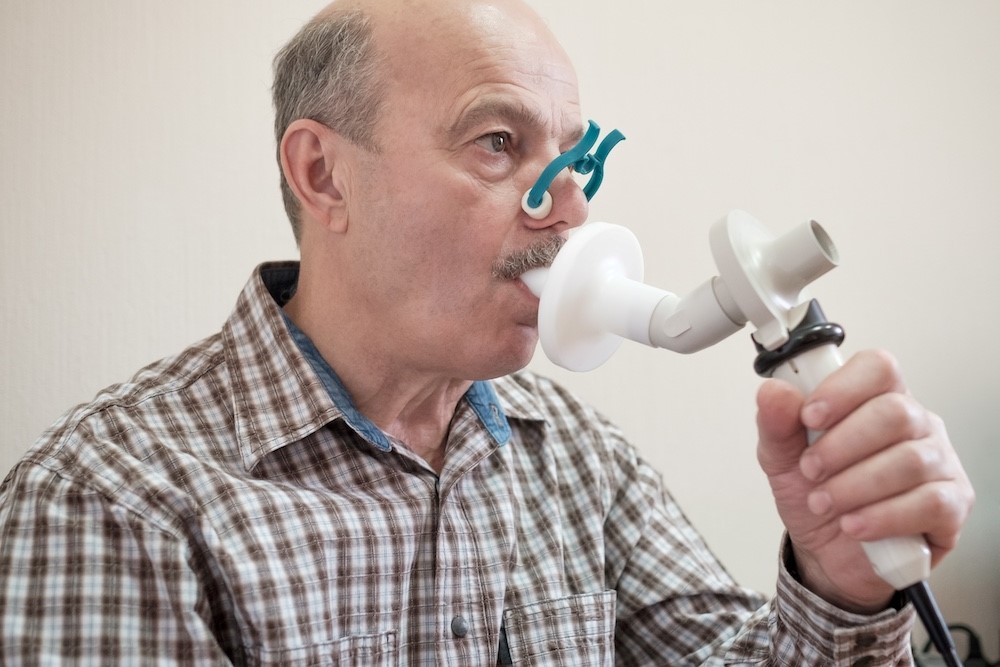What is Spirometry Testing?
Spirometry is a type of lung function test that determines your inhalation and exhalation capacity, as well as the ease and speed of your exhale.1 This test measures your lung capacity, and can help identify any airflow restrictions, or irregularities in your breathing pattern.
The test involves a spirometer, a device that measures various parameters of your breathing. During the test, you will be asked to take a deep breath and exhale forcefully into a mouthpiece attached to the spirometer. Some spirometer then generates a graph called a spirogram, which shows how your lung function compares to predicted values based on your age, height, weight, and sex.2
Key spirometry measurements include:
- Forced vital capacity (FVC): This is the largest amount of air you can forcefully exhale after breathing in as deeply as possible. A lower-than-normal FVC reading indicates restricted breathing.3
- Forced expiratory volume (FEV): This is how much air you can force from your lungs in one second. This reading helps your doctor assess the severity of your breathing problems. Lower FEV-1 readings potentially indicate an obstruction.4
Why is spirometry testing important?
- Diagnosis of respiratory conditions: Spirometry can help play a role in diagnosing and differentiating between various respiratory conditions such as asthma, Chronic Obstructive Pulmonary Disease (COPD), and restrictive lung disease.5 It helps identify the presence and severity of airflow obstruction, which is a typical symptom of many lung diseases.
- Monitoring disease progression: For individuals already diagnosed with respiratory conditions like asthma or COPD, spirometry testing can provide information about disease progression. Regular testing can help identify a decline in lung function, enabling healthcare providers to adjust treatment plans accordingly.
- Assessing treatment effectiveness: Spirometry testing can help evaluate the effectiveness of medications and other interventions prescribed for respiratory conditions.6 By measuring changes in lung function, healthcare professionals can determine if the treatment plan is working optimally or requires adjustments.
- Screening high-risk individuals: Spirometry can also be used as a screening tool for individuals at high risk of developing lung disease.7 This includes smokers, individuals exposed to occupational hazards (e.g., asbestos or dust), and those with a family history of lung disease. Early detection through spirometry testing can help with timely interventions and may improve the chances of better outcomes.
Spirometry testing can be a valuable tool in assessing lung function, assisting in the diagnosis of respiratory conditions, and monitoring disease progression. By measuring key parameters of respiratory performance, spirometry provides important information that can help to guide treatment decisions and help individuals maintain optimal lung health. Whether you're experiencing breathing difficulties or simply looking for a comprehensive lung assessment, spirometry testing is essential to respiratory care.8
1 https://www.healthline.com/health/spirometry#results
2 https://www.healthline.com/health/spirometry#results
3 https://www.mayoclinic.org/tests-procedures/spirometry/about/pac-20385201
4 https://www.mayoclinic.org/tests-procedures/spirometry/about/pac-20385201
5 https://www.lung.org/lung-health-diseases/lung-procedures-and-tests/spirometry#
6 https://www.mayoclinic.org/tests-procedures/spirometry/about/pac-20385201
7 https://my.clevelandclinic.org/health/diagnostics/17833-spirometry
8 https://www.physio-pedia.com/Spirometry


